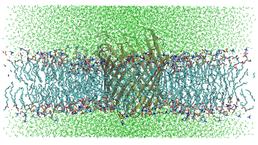Multi-scale simulations of bacterial outer-membrane proteins
- Started
- 3rd October 2011
- Research Team
- Jamie Parkin
- Investigators
- Syma Khalid

An OpdL protein (gold) in a DMPC lipid bilayer (cyan, blue, and red), surrounded by water (green). This system contains ~45000 atoms.
Pseudomonas aeruginosa is a Gram-negative bacterium (possessing an inner and outer membrane at the surface of the cell) that is a pathogen to people with compromised immune systems. P. aeruginosa has the potential to cause pneumonia, and infections of the bacteria in damaged tissue can cause inflammation and sepsis. Studies have shown that one group particularly affected are patients with Cystic Fibrosis. There are antibiotics available that target P. aeruginosa, but one major issue with this bacterium is that it is notoriously resilient to antibiotics and disinfectants. P. aeruginosa has several methods of resistance towards unknown and unwanted drug molecules. The first is a very resistant outer membrane; the outer leaflet of the outer membrane comprises of lipopolysaccharide molecules, tightly bound together by divalent cations, Mg2+ and Ca2+. The second, unlike most other Gram-negative bacteria, nutrient uptake is controlled by substrate specific protein channels in the outer membrane, these proteins are mostly from the OprD protein family, where each protein has a particular series of substrates it is responsible for. This is as issue as it makes the uptake of particular drug molecules more difficult, and thus drug design has to be more specific. The third is a triad of proteins, containing the outer membrane protein OprM and proteins MexA and MexB, these collectively promote the efflux of unwanted substrates from the bacterium. Finally, it has been shown that for current antibiotics in use 75% of patients have shown decreased susceptibility to the drugs molecules over time; as genes within P. aeruginosa reduce expression of the proteins that are allowing passage of the drug molecules, e.g. the OprD protein and the passage of carabapenems.
The pathogenic behaviour of P. aeruginosa as well as its specific resistance to antibiotics makes it an obvious target of interest. Using recently resolved X-ray structures of a number of proteins from the OprD protein family, I plan to explore and understand the process of specific substrate uptake by these proteins. Using GROMACS, a Molecular Dynamics (MD) package designed for the simulation of proteins and lipids, I will simulate the each protein in a membrane that resembles that of the outer membrane of P. aeruginosa. The simulations use force fields to calculate the potential energy of interactions between all atoms in a simulation and then calculate the trajectory of the atoms over time. In particular, I plan to observe the loop region of the proteins and how they interact with the substrates, as well as docking studies and free energy calculations to see if there are favourable binding positions of the substrates within their respective proteins. Hopefully, the exploration and understanding of these proteins can lead to sufficient knowledge as to aid drug design and ultimately benefit patients suffering from P. aeruginosa based infections and diseases.
Categories
Life sciences simulation: Bioinformatics, Biomolecular simulations
Algorithms and computational methods: Molecular Dynamics
Simulation software: Gromacs
Visualisation and data handling software: VMD, Xmgrace
Computational platforms: Mac OS X